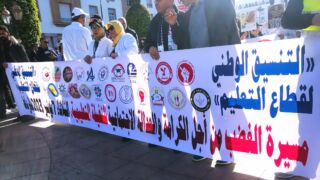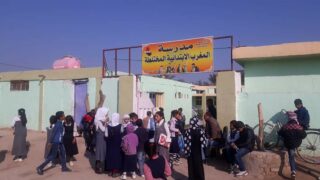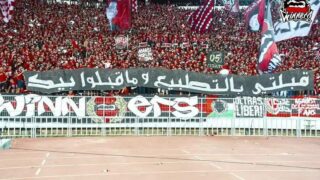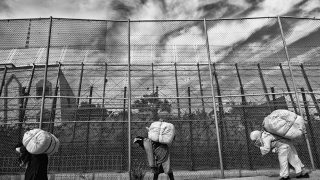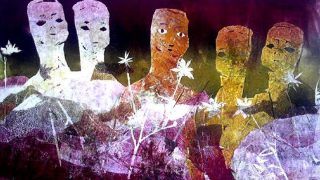Here they sell sheep … here is the "sheep hotel" … straw, coal, onions, knives and other tools meant for grilling. Between each market and "hotel" is a dumpster, and near each dumpster are warnings posted on the walls: "Cleanliness is a part of faith," "Place trash here" and "Please do not urinate here."
In almost all of the city's districts, especially in the suburbs, sheep owners set up shops in tents where they sell their goods. Because the apartments are small, the vendors raise the sheep until the morning of the feast. Thus, they had posted a sign on the dirty tent: "Five star sheep hotel." This is conclusive evidence of the importance of meat in society. During Eid al-Fitr, relatives merely exchange phone calls. However, during Eid al-Adha, it is necessary to visit other people's homes and share meals.
Fatty sheep are particularly prized. To entertain the sheep and calves, the "hotel guard" takes them out of the tent in the early morning for a short stroll. You can only imagine the scene after the slaughter. … At this time, the "civilized face" of the city disappears, and it is dominated by the "Bedouin lifestyle."
King Mohammed VI was angry when he spoke in parliament in Casablanca at the opening of the new legislative session on Oct. 11, 2013. The king said he had been carrying out tours of the city's various neighborhoods since 1999, to access the conditions. This is what he concluded:
"Casablanca is a city of glaring social inequalities, where the rich live alongside the poor. It is a city of both high-rise towers and slums. It is a financial and business center as well as a center of misery, unemployment and so on. Furthermore, there is waste and dirt that pollutes the city and distorts its reputation."
The king concluded with a rhetorical question: "Yet, why has this city, which is one of the wealthiest in Morocco, not realized the tangible progress that its male and female residents aspire for, like that realized by a number of other cities?"
Casablanca's residents rejoiced, because the best solutions are those that arise from the king's anger. The city's mayor immediately announced a war on garbage. While waiting for the results, we must ask: How did Casablanca reach this miserable situation?
In terms of local management, the mayor's office has never been characterized by partisan agreement. Rather, the city's path has been marked by coalitions whose members fight with one another and accuse the other of what they are all guilty of. Partisan quotas have led to an excess of public employees in the city. The city employs 17,400 public servants, while in fact only one-third of this number is needed. This has depleted the city's budget, as Casablanca rapidly expands. Newcomers have settled in the plains surrounding the city, which received intensive waves of migration. The population has increased from 20,000 in 1900 to more than 5 million in 2012.
Politically, the city witnessed violent uprisings in the era of King Hassan II, in 1965, 1981 and 1984. Thus, the security forces have been cautious when dealing with Casablancans. The late king had experienced difficulties when it came to controlling uprisings in major cities, and he realized that Casablanca was a bellwether for all of Morocco. Thus, it was divided into five, and later six, prefectures. This deprived its leaders of a comprehensive vision for the future, and division overcame "administration." Residents were left to fend for themselves, after the state withdrew from the field of development and paved the way for the police administration in this field.
The city is located in a fertile agricultural region in the heart of "productive Morocco," the area that was first occupied by the French in 1907. The arid mountain regions of the country were not occupied until 1930. Hubert Lyautey, a French army general, had described these areas as "nonproductive Morocco." He meant that these regions were not useful for the French, of course. Thanks to Casablanca's prime location, it receives food from all directions — from the land and the sea. Thus, food prices are reasonable, despite the high cost of housing. Everywhere in the city there are donkey-drawn carts carrying fresh fruits and vegetables, harvested just hours prior. [In Casablanca], food does not sit in supermarket freezers for hundreds of hours. It is a city that monopolizes a third of Morocco's industry. This has made it a "metropolis," attracting a huge number of migrants, particularly from Morocco's southern and eastern regions. Thus, those who [complain] that Casablanca's budget is double that of Fez, neglect to mention that the former's population is many times that of the latter. This is despite the fact that when Fez was established, Casablanca did not even exist. Casablanca appeared for political reasons, when the colonizers established coastal cities to weaken the influence of the conservative cities in the interior. These new cities included the elite that would rule independent Morocco.
In the high-end neighborhoods — where the "original" Casablancans live — the residents are nostalgic for the city as it was at the beginning of independence. This was before it was assaulted by "Arabism" — or Bedouin Arabs who occupy the public domain and engage in unstructured economic activity. The "city folk" scoff at the Bedouins and say that these slums have become the norm.
Where do outsiders stand? This is the opinion of those who benefit from a structured economic system; they live in modern neighborhoods and ignore the fact that modernity is costly. It is hard for one with full pockets to understand the brutality of need.
The slums — in the other's point of view — are a blessing for those who do not have a degree, a job or the resources to live. These slums are opening and welcoming, and appropriate for those uprooted from other regions, particularly women. This is because the big city liberates the women from social constraints and gives them the chance to redefine themselves, away from tribal customs and their "nonforgiving" approach.
Hundreds of thousands of people come [to the city], where free trade is widely available. They start small projects, sometimes without capital, or borrow whatever goods they may need. Some merely set up a small tent and call it a restaurant or "a factory for repairing pressure cookers." … These "Arab" migrants depend on their muscles to earn a living. They work long hours and have no time or energy to think. This repetitive work strengthens their muscles, yet weakens their minds. This physical exhaustion prevents them from engaging in any cultural efforts. Given their situation, they demand nothing, thus granting the state total peace. Even when their carts are confiscated, they do not light themselves on fire [in protest].
However, these migrants still do not achieve peace. Theatrical performances, television shows and films have dedicated a lot of time to making fun of the figure of the "Bedouin in Casablanca." Moreover, many Moroccan comedians ridicule the Bedouins, contributing to discrimination and targeting. In these comedic sketches, the Bedouins speak in a funny accent, using a lexicon that is becoming extinct. They are naive, lost in the big city and easy to take advantage of, since they are not as intelligent as the "city folk." This is vulgar and foul comedy, which garners few laughs. It insults the dignity of the spectator and goes beyond reality. It is a type of superficial humor that fails to capture the spirit of Casablanca.
Translated by Al-Monitor

